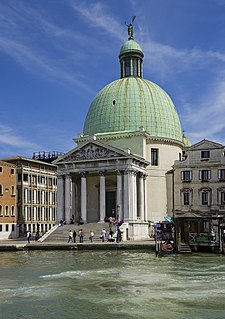
The Palazzo Corner Gheltof is Gothic-style palace located on the Grand Canal, in the Sestieri of San Marco, adjacent to the Palazzi Mocenigo, in Venice, Italy.
Coordinates: 2000 45°26′06″N12°19′45″E / 45.43502°N 12.32915°E

The Palazzo Corner Gheltof is Gothic-style palace located on the Grand Canal, in the Sestieri of San Marco, adjacent to the Palazzi Mocenigo, in Venice, Italy.
Coordinates: 2000 45°26′06″N12°19′45″E / 45.43502°N 12.32915°E
The building has undergone a number of renovations, including a major one in the 16th century. [1]

Cannaregio is the northernmost of the six historic sestieri (districts) of Venice. It is the second largest sestiere by land area and the largest by population, with 13,169 people as of 2007.

Piazza di Spagna, at the bottom of the Spanish Steps, is one of the most famous squares in Rome (Italy). It owes its name to the Palazzo di Spagna, seat of the Embassy of Spain to the Holy See. Nearby is the famed Column of the Immaculate Conception of the Blessed Virgin Mary.

Dorsoduro is one of the six sestieri of Venice, in northern Italy.

Santa Croce is one of the six sestieri of Venice, northern Italy.

The Campo San Polo is the largest campo in Venice, Italy, the second largest Venetian public square after the Piazza San Marco. It is located in the Sestiere San Polo.

Palazzo Farnese is a palace in Piacenza, northern Italy.

The Palazzo Grimani di San Luca is a Renaissance-style palace, located between the Palazzo Corner Valmarana and the Rio di San Luca and the flanking Palazzo Corner Contarini dei Cavalli on the Grand Canal in the sestiere of San Marco of the city of Venice, Italy.

The Loggia Palace is a Venetian Gothic palace in Koper, a port town in southwestern Slovenia. It is the only preserved Gothic town hall in Slovenia.

Sant'Eligio degli Orefici is a church in Rome, Italy. It is located in the rione Regola, near via Giulia, on a corner of the via of the same name that ends below the Lungotevere dei Tebaldi, a few blocks northwest of the Palazzo Farnese.

Via de' Tornabuoni, or Via Tornabuoni, is a street at the center of Florence, Italy, that goes from Antinori square to ponte Santa Trinita, across Santa Trinita square, characterized by the presence of fashion boutiques.

Porta Magenta, formerly known as Porta Vercellina, was one of the city gates of Milan, Italy. The gate was established in the 9th century, with the Roman walls of the city; it was moved with the medieval and Spanish walls, and was finally demolished in the 19th century. The phrase "Porta Magenta" is now used to refer to the district ("quartiere") where the gate used to be; the district is part of the Zone 7 administrative division of Milan, west of the city centre.

Palazzo dei Dieci Savi is a palace on the Canal Grande, Venice, northern Italy. It is included in the sestiere (quarter) of San Polo, and is not far from the Rialto Bridge, on the opposite side than the Palazzo dei Camerlenghi.

The Palazzo Corner Spinelli is a palace in Venice, northern Italy, located on the Grand Canal, in the sestiere of San Marco. It stands across the canal from the Palazzo Querini Dubois.

Palazzo Corner della Ca' Granda, also called Ca' Corner della Ca' Granda or simply Palazzo Corner or Palazzo Cornaro, is a Renaissance-style palace located between the Casina delle Rose and the Rio di San Maurizio (Venice), across the Grand Canal from the Palazzo Venier dei Leoni, in the city of Venice, Italy. It is the current seat of the province of Venice and of the city's prefect.

Palazzo Dolfin Manin is a palace in the sestiere of San Marco on the Canal Grande of Venice, northern Italy. It is located near the Palazzo Bembo and Palazzo Dandolo Paolucci, not far from the Rialto Bridge.

The Palazzo Pesaro Papafava or Palazzo Papafava is a 15th-century Gothic style palace in the sestiere of Cannaregio of Venice, Italy. Located on the Canale della Misericordia, near the corner with Rio di San Felice; it stands across from the Scuola Grande di Santa Maria della Misericordia.

The Palazzo Giustinian Persico is an early-Renaissance-style palace located at the corner with the Rio di San Tomà, near Palazzo Tiepolo and across the canal from Palazzi Mocenigo on the Grand Canal, in the Sestieri of San Polo, Venice, Italy.

The Palazzo Querini Dubois, also known as Giustinian Querini is a Renaissance-style palace in located on the Grand Canal, between the Palazzo Bernardo a San Polo and the Palazzo Grimani Marcello in the sestiere of San Polo of Venice, Italy. It stands across the canal from the Palazzo Corner Spinelli. A second façade faces the rio delle Erbe. Opposite is Palazzo Querini Benzon.
Karkabo was a town of ancient Lycia.

Palazzo Correr Contarini Zorzi is a Renaissance palace in Venice, Italy, overlooking the Grand Canal and locating in the Cannaregio district between Palazzo Querini Papozze and Palazzo Gritti. The palazzo is also known as Ca' dei Cuori, a family whose wrought iron coats of arms is present on the façade.